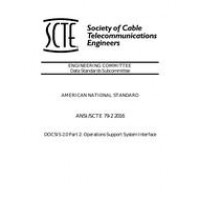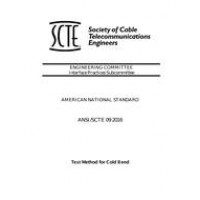SCTE 24-9 2016
- IPCablecom 1.0 Part 9: Event Message Requirements
- standard by Society of Cable Telecommunication Engineers, 2016
- Category: SCTE
$50.00
$25.00
The scope of this document encompasses the definition of the Event Message architecture; the services for which Event Messages are defined; the set of Event Messages defined for each supported service; the format and coding of the Event Messages; and finally the transport protocol used to pass Event Messages between IPCablecom network elements.
The Event Messages are designed to be flexible and extensible in order to support new and innovative IPCablecom and value-added services. In an effort to describe some of these features and possible uses of these Event Messages, this document may describe interfaces and signaling protocols that are outside the scope of IPCablecom 1.0. It should be understood that the primary purpose of this document is to support the IPCablecom 1.x architecture and the IPCablecom 1.0 services as defined in this document.
In order to support early deployment of IPCablecom networks, the IPCablecom project is developing specifications in a phased approach. In an effort to keep pace with the larger IPCablecom project and interface specification development effort, the Event Messages are also addressed in a phased approach. Possible future extensions to this document may include topics such as expanded support for fraud detection and other back office applications.
From time to time this document refers to the voice communications capabilities of an IPCablecom network in terms of "IP Telephony." The legal/regulatory classification of IP-based voice communications provided over cable networks and otherwise, and the legal/regulatory obligations, if any, borne by providers of such voice communications, are not yet fully defined by appropriate legal and regulatory authorities. Nothing in this document is addressed to, or intended to affect, those issues. In particular, while this document uses standard terms such as "call," "call signaling," "telephony," etc., it should be recalled that while an IPCablecom network performs activities analogous to these PSTN functions, the manner by which it does so differs considerably from the manner in which they are performed in the PSTN by telecommunications carriers, and that these differences may be significant for legal/regulatory purposes. Moreover, while reference is made here to "IP Telephony," it should be recognized that this term embraces a number of different technologies and network architecture, each with different potential associated legal/regulatory obligations. No particular legal/regulatory consequences are assumed or implied by the use of this term.
The Event Messages are designed to be flexible and extensible in order to support new and innovative IPCablecom and value-added services. In an effort to describe some of these features and possible uses of these Event Messages, this document may describe interfaces and signaling protocols that are outside the scope of IPCablecom 1.0. It should be understood that the primary purpose of this document is to support the IPCablecom 1.x architecture and the IPCablecom 1.0 services as defined in this document.
In order to support early deployment of IPCablecom networks, the IPCablecom project is developing specifications in a phased approach. In an effort to keep pace with the larger IPCablecom project and interface specification development effort, the Event Messages are also addressed in a phased approach. Possible future extensions to this document may include topics such as expanded support for fraud detection and other back office applications.
From time to time this document refers to the voice communications capabilities of an IPCablecom network in terms of "IP Telephony." The legal/regulatory classification of IP-based voice communications provided over cable networks and otherwise, and the legal/regulatory obligations, if any, borne by providers of such voice communications, are not yet fully defined by appropriate legal and regulatory authorities. Nothing in this document is addressed to, or intended to affect, those issues. In particular, while this document uses standard terms such as "call," "call signaling," "telephony," etc., it should be recalled that while an IPCablecom network performs activities analogous to these PSTN functions, the manner by which it does so differs considerably from the manner in which they are performed in the PSTN by telecommunications carriers, and that these differences may be significant for legal/regulatory purposes. Moreover, while reference is made here to "IP Telephony," it should be recognized that this term embraces a number of different technologies and network architecture, each with different potential associated legal/regulatory obligations. No particular legal/regulatory consequences are assumed or implied by the use of this term.
 PDF
PDF
All of our standards document are available in PDF (Portable Document Format), an electronic, downloadable format.You will be able to download the file in your account downloads.
 Multi-User Access
Multi-User Access
After purchasing, you have the ability to assign each license to a specific user.
 Printable
Printable
At any time, you are permitted to make printed copies for your and your members' reference use.





